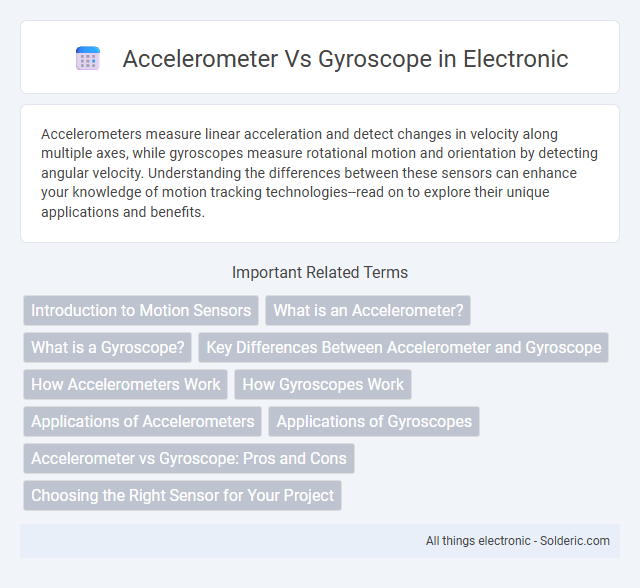Accelerometers measure linear acceleration and detect changes in velocity along multiple axes, while gyroscopes measure rotational motion and orientation by detecting angular velocity. Understanding the differences between these sensors can enhance your knowledge of motion tracking technologies--read on to explore their unique applications and benefits.
Comparison Table
| Feature | Accelerometer | Gyroscope |
|---|---|---|
| Function | Measures linear acceleration along X, Y, Z axes | Measures angular velocity/rotation around X, Y, Z axes |
| Primary Use | Detects movement, orientation, tilt, vibration | Detects rotational motion, angular position, stability |
| Output Data | Acceleration in m/s2 | Angular velocity in degrees/sec or radians/sec |
| Sensitivity | High sensitivity to linear motion | High sensitivity to rotational motion |
| Sensor Type | Microelectromechanical systems (MEMS) sensor | MEMS or vibrating structure gyroscope |
| Applications | Smartphones, fitness trackers, vehicle dynamics | Gaming controllers, drones, VR headsets, navigation |
| Advantages | Simple, low power, cost-effective for movement detection | Precise rotational measurement, improves orientation accuracy |
| Limitations | Cannot measure rotation directly | More complex, higher power consumption than accelerometer |
Introduction to Motion Sensors
Motion sensors, including accelerometers and gyroscopes, detect changes in position and movement to provide essential data for devices like smartphones, drones, and fitness trackers. Accelerometers measure linear acceleration along multiple axes, capturing gravity and motion forces, while gyroscopes track angular velocity to detect rotational movement. Understanding the differences between these sensors helps you choose the right technology for precise motion tracking and orientation detection.
What is an Accelerometer?
An accelerometer is a sensor that measures the acceleration forces acting on an object, including gravity, enabling the detection of changes in velocity and orientation. It plays a crucial role in applications such as mobile devices, fitness trackers, and automotive safety systems by providing precise motion and tilt data. Understanding how an accelerometer works helps you optimize device performance and accuracy in tracking movement.
What is a Gyroscope?
A gyroscope is a sensor that measures angular velocity and orientation by detecting changes in rotational motion. It uses the principles of angular momentum to provide precise information about an object's rotational position, enabling accurate tracking in applications such as smartphones, drones, and navigation systems. Unlike an accelerometer, which measures linear acceleration, a gyroscope specifically captures rotational movement, making it essential for stability and motion sensing technologies.
Key Differences Between Accelerometer and Gyroscope
Accelerometers measure linear acceleration along one or multiple axes, detecting changes in velocity relative to free fall, making them ideal for tilt sensing and motion detection. Gyroscopes measure angular velocity, capturing rotational movement to determine orientation and rate of rotation with high precision. Your choice between an accelerometer and a gyroscope depends on whether you need to track linear acceleration or rotational movement in applications like smartphones, drones, or fitness trackers.
How Accelerometers Work
Accelerometers measure acceleration forces by detecting changes in capacitance, piezoelectric effects, or resistive properties within a microelectromechanical system (MEMS). These forces cause tiny internal structures to shift, enabling the sensor to calculate linear movement along one or more axes. This precise measurement of acceleration enables applications in motion detection, orientation, and vibration analysis.
How Gyroscopes Work
Gyroscopes measure angular velocity by detecting changes in orientation using the principles of angular momentum. They contain a spinning rotor or vibrating structure that maintains its orientation, allowing the device to sense rotational movement around one or more axes. This capability enables gyroscopes to provide precise data for navigation, stabilization, and motion tracking in applications ranging from smartphones to aerospace systems.
Applications of Accelerometers
Accelerometers are widely used in applications such as smartphone screen orientation detection, fitness tracking through step counting, and automotive airbag deployment systems. They measure linear acceleration and vibration, enabling motion sensing and impact detection in consumer electronics, aviation, and industrial machinery. Compared to gyroscopes, accelerometers provide essential data for tilt measurement and vibration analysis, making them critical for navigation and safety systems.
Applications of Gyroscopes
Gyroscopes are integral in navigation systems, enabling precise orientation and stability control in aircraft, ships, and smartphones. They are extensively used in virtual reality headsets and drones to detect rotational movement and maintain balance. Your devices rely on gyroscopes to enhance motion tracking and improve user experience in gaming and augmented reality applications.
Accelerometer vs Gyroscope: Pros and Cons
Accelerometers excel in measuring linear acceleration and detecting orientation changes with low power consumption, making them ideal for simple motion detection and tilt sensing. Gyroscopes provide precise angular velocity and rotational motion data, enhancing accuracy in navigation and stabilization but often consume more power and are sensitive to drift over time. Combining both sensors offers complementary benefits for comprehensive motion tracking, though cost and complexity increase accordingly.
Choosing the Right Sensor for Your Project
Choosing the right sensor for your project depends on whether you need to measure linear acceleration or angular velocity; accelerometers detect changes in velocity along the X, Y, and Z axes, making them ideal for tracking motion and orientation. Gyroscopes measure rotational speed around these axes, providing precise data for applications like stabilization and navigation systems. For comprehensive motion sensing, many projects combine both sensors to leverage accelerometers' ability to detect tilt and gyroscopes' accuracy in rotation detection.
accelerometer vs gyroscope Infographic

 solderic.com
solderic.com